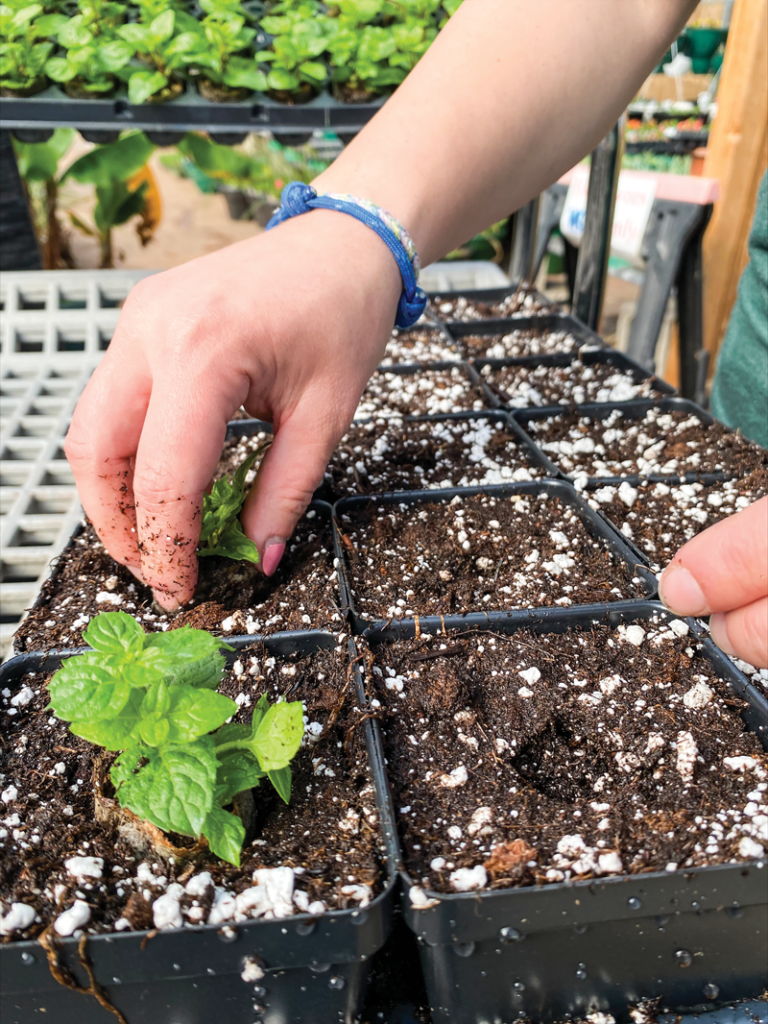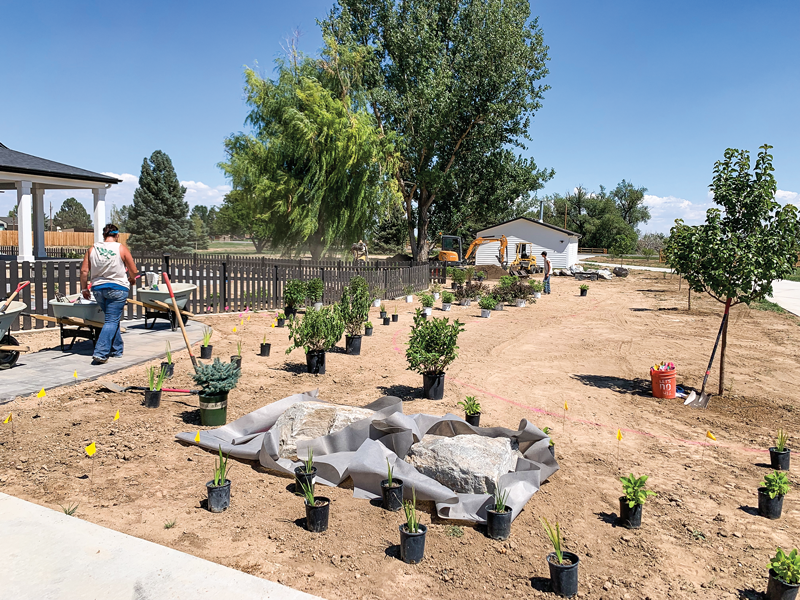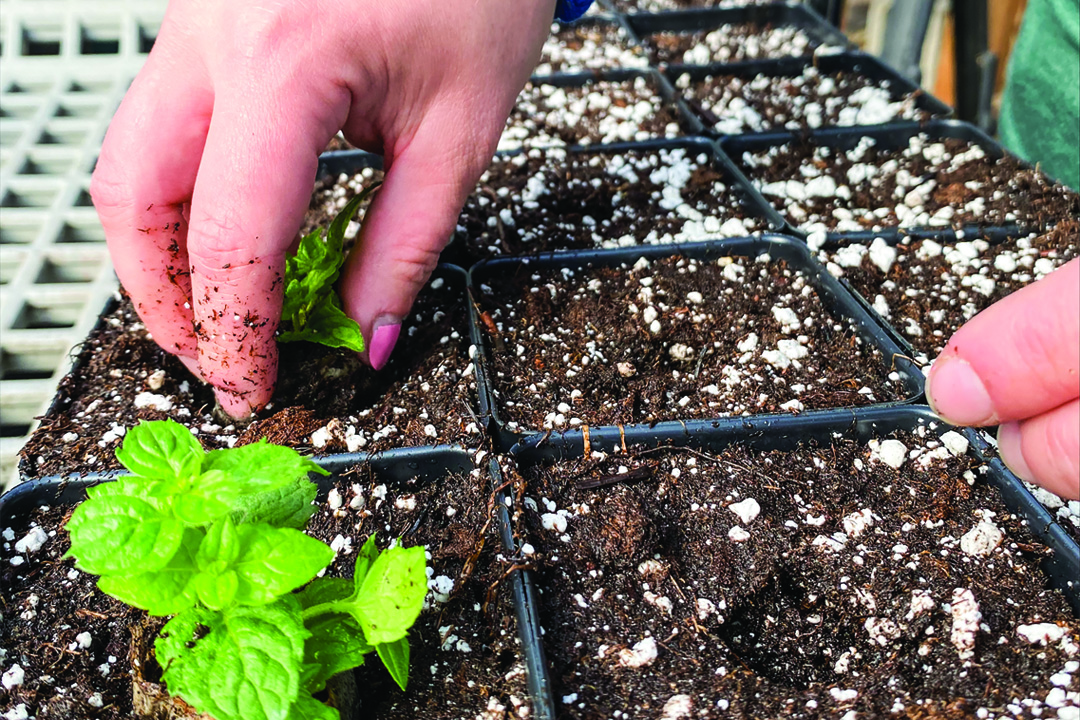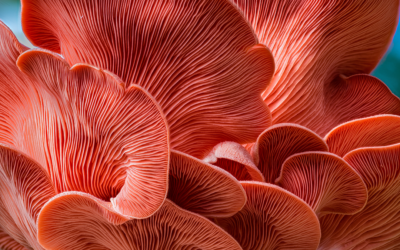April showers bring May flowers, but there’s more to spring garden prep than waiting for the rain to fall. Raised beds need amending and the thawed ground needs tilling before the last frost gives us the go-ahead to plant after Mother’s Day.
How you amend your soil varies based on the type of garden you have, says Michelle Heronema, greenhouse manager at The Windsor Gardener, and not all gardens require the same soil recipe in order to produce beautiful blooms or a bountiful vegetable harvest.
“Raised beds allow you to start with a fresh soil mixture that is lightweight and easy for tender roots to penetrate, whereas planting in the ground poses the challenge of breaking up the dense clay soil.”

Planting mint into trays. Photo courtesy of Windsor Gardner.
Filling and topping off raised beds
If you’re filling new raised garden beds, Heronema recommends using a ratio of one-third compost to two-thirds topsoil, or if you don’t mind spending the extra cash, to fill the beds with a ready-made raised bed mix (EKO Raised Bed Mix is her favorite). For those who choose the DIY method, it’s important to mix the compost and topsoil thoroughly so you aren’t planting directly into the compost. This can cause your crops to burn, not produce fruit or die off completely.
Amending last year’s raised beds is easy. All you need to do is spread an inch-thick layer of compost across the top and work it down into the soil to replace the nutrients that were sucked out by previous crops. Heronema suggests using a plant-based compost (such as mushroom compost or cotton burr compost) rather than an animal-based compost because those products can add excess salt to the soil, making it too “hot” to plant in.
Quality composts should be well-aged and have a soil-like consistency, so avoid home compost with visible food chunks or fresh manure from your neighbor’s horses. Well-composted organic matter invites more diverse microbial growth in the soil, helps with aeration and promotes healthy roots and overall plant health, setting your raised beds up for successful planting.

When planting perennials, it is better to amend the soil in the individual holes you plant into. Photo courtesy of Lindgren Landscape.
Breaking ground on clay soil
Whereas raised beds are filled with a fluffy bagged mix or a combination of topsoil and compost, in-ground gardens are chock-full of dense clay soil. Though it may be tempting to remove the native soil and replace it with raised bed mix, Heronema says this will only create a container in the ground that retains water and doesn’t give the roots much room to grow.
Instead, she says to heavily amend it by tilling up the soil and mixing in a few inches of compost so the roots can gradually ease themselves into the clay: “If you’re amending an area from scratch, try to work the compost in as deep as you can, ideally 12 inches or so, and keep that ratio of one-third compost to two-thirds existing soil. Every year after that, put down another inch of compost and work it in.”
Aside from adding nutrients and microorganisms to your garden, the main purpose of amending our heavy clay soil is to break it up so that crops can root out easily and water can drain evenly rather than pooling up. If you spread a layer of compost or topsoil on top and don’t mix it in, the water might drain really well through the nice soil on top then deadpan when it hits the clay soil underneath, keeping the roots wet a lot longer and potentially causing them to rot.
Amend separately for perennials
When planting a perennial garden in your landscape, it’s better to amend the soil in each hole you dig than amending an entire garden bed, says Jill White, small construction/service and repair salesperson at Lindgren Landscape in Fort Collins. However, many of the same rules apply: use a plant-based compost, keep a ratio of one-third compost to two-thirds native soil and mix it in thoroughly before you backfill the hole.
“Cotton burr compost and mushroom compost are great options because they are a byproduct of things that people already use, as opposed to a less sustainable, mined option like peat moss, which retains water in areas that are used to drought,” she explains. “I really like cotton burr compost for perennials because it does a good job of breaking up the heavy clay and helps to balance our naturally alkaline soil by adding some acidity.”
Unless you’re running into problems with your soil (or you’re turning a parking lot into a perennial garden), White says soil tests and extra amendments aren’t usually necessary. In addition to compost, all she recommends is a small dose of rooting fertilizer to help your perennials acclimate to their new home.
Every year after that, you’ll want to feed your perennials with a fertilizer high in phosphorus, the main nutrient needed to produce flowers and fruit. Annuals and vegetables also need phosphorus after planting, otherwise your spring amending efforts will only produce leafy plants with no blooms or crops to show for it.
__________________________________________________
Laurel Aiello is a Fort Collins native and CSU alum. When she isn’t writing, you’ll find her out in the garden, reading a good book or soaking up the sunshine with her husband and pup.







